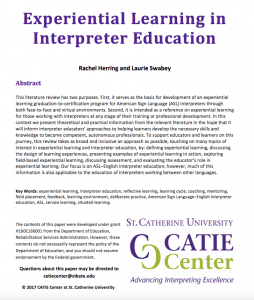by Rachel Herring and Laurie Swabey

This review of the literature related to experiential learning in interpreter education addresses the following topics:
- What is Experiential Learning?
- Designing Experiences for Learning
- Experiential Learning in Action: Examples from the Interpreting Studies Literature
- Field-Based Experiential Learning
- Assessment
- The Educator in Experiential Learning
The document is 90 pages long.
Abstract
This literature review has two purposes. First, it serves as the basis for development of an experiential learning graduation-to-certification program for American Sign Language (ASL) interpreters through both face-to-face and virtual environments. Second, it is intended as a reference on experiential learning for those working with interpreters at any stage of their training or professional development. In this context we present theoretical and practical information from the relevant literature in the hope that it will inform interpreter educators’ approaches to helping learners develop the necessary skills and knowledge to become competent, autonomous professionals. To support educators and learners on this journey, this review takes as broad and inclusive an approach as possible, touching on many topics of interest in experiential learning and interpreter education, by: defining experiential learning, discussing the design of learning experiences, presenting examples of experiential learning in action, exploring field-based experiential learning, discussing assessment, and evaluating the educator’s role in experiential learning. Our focus is on ASL-English interpreter education; however, much of this information is also applicable to the education of interpreters working between other languages.
Key Words:
experiential learning, interpreter education, reflective learning, learning cycle, coaching, mentoring, field placement, feedback, learning environment, deliberate practice, American Sign Language–English interpreter education, ASL, service learning, situated learning.
ASL Version of Abstract
The contents of this video and paper were developed under grant H160C160001 from the Department of Education, Rehabilitation Services Administration. However, these contents do not necessarily represent the policy of the Department of Education, and you should not assume endorsement by the Federal government.
Questions about this paper may be directed to catiecenter@stkate.edu
©2017 CATIE Center at St. Catherine University
